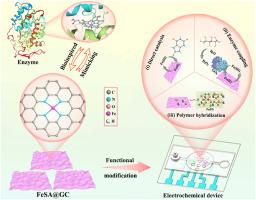Single-atom FeN4 sites embedded graphene-like carbon as a versatile reinforcing material for electrochemical sensing
IF 11.6
2区 材料科学
Q1 CHEMISTRY, PHYSICAL
引用次数: 0
Abstract
Despite significant progress, electrochemical sensors still face some challenges, including the rational design of versatile sensing materials and in-depth elucidation of their sensing mechanisms. In this work, we investigated a kind of bio-inspired material, namely single-atom FeN4 sites embedded graphene-like carbon (FeSA@GC), as a versatile reinforcing material for electrochemical sensing. By integrating the merits of atomically dispersed active sites with highly conductive carbon matrix, the FeSA@GC exhibited desirable catalytic activity and rapid electron-transfer kinetics. Density functional theory calculations further revealed that the FeN4 active sites within FeSA@GC play a crucial role in substrate activation and catalytic turnover. As a proof-of-concept application, we developed a novel electrochemical device based on FeSA@GC and its further coupling/hybridization modification, which enabled multiplex detection of physiological biomarkers (uric acid, glucose, and pH). Our research is believed to provide a promising guidance for the rational design of versatile sensing material, and promote the application of electrochemical sensing in biomedical field.

单原子FeN4位嵌入石墨烯样碳作为电化学传感的多功能增强材料
尽管取得了重大进展,但电化学传感器仍然面临着一些挑战,包括合理设计通用传感材料和深入阐明其传感机理。在这项工作中,我们研究了一种仿生材料,即嵌入石墨烯样碳的单原子FeN4位点(FeSA@GC),作为电化学传感的多功能增强材料。通过整合原子分散活性位点与高导电性碳基体的优点,FeSA@GC具有理想的催化活性和快速的电子转移动力学。密度泛函理论计算进一步揭示了FeSA@GC内的FeN4活性位点在底物活化和催化周转中起着至关重要的作用。作为概念验证应用,我们开发了一种基于FeSA@GC及其进一步偶联/杂交修饰的新型电化学装置,可以多重检测生理生物标志物(尿酸,葡萄糖和pH)。我们的研究为合理设计多用途传感材料,促进电化学传感在生物医学领域的应用提供了良好的指导。
本文章由计算机程序翻译,如有差异,请以英文原文为准。
求助全文
约1分钟内获得全文
求助全文
来源期刊

Carbon
工程技术-材料科学:综合
CiteScore
20.80
自引率
7.30%
发文量
0
审稿时长
23 days
期刊介绍:
The journal Carbon is an international multidisciplinary forum for communicating scientific advances in the field of carbon materials. It reports new findings related to the formation, structure, properties, behaviors, and technological applications of carbons. Carbons are a broad class of ordered or disordered solid phases composed primarily of elemental carbon, including but not limited to carbon black, carbon fibers and filaments, carbon nanotubes, diamond and diamond-like carbon, fullerenes, glassy carbon, graphite, graphene, graphene-oxide, porous carbons, pyrolytic carbon, and other sp2 and non-sp2 hybridized carbon systems. Carbon is the companion title to the open access journal Carbon Trends. Relevant application areas for carbon materials include biology and medicine, catalysis, electronic, optoelectronic, spintronic, high-frequency, and photonic devices, energy storage and conversion systems, environmental applications and water treatment, smart materials and systems, and structural and thermal applications.
 求助内容:
求助内容: 应助结果提醒方式:
应助结果提醒方式:


